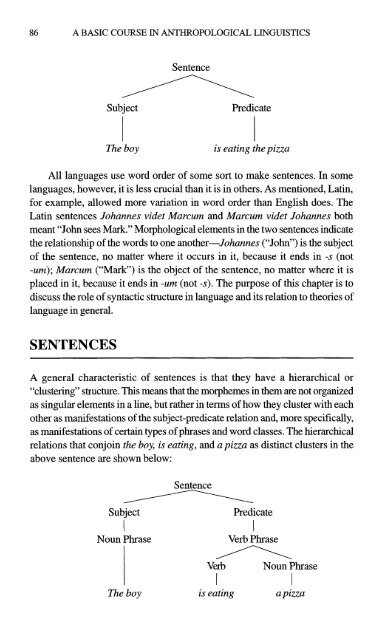A Basic Course in Anthropological Linguistics (Studies in Linguistic ...
A Basic Course in Anthropological Linguistics (Studies in Linguistic ...
A Basic Course in Anthropological Linguistics (Studies in Linguistic ...
Create successful ePaper yourself
Turn your PDF publications into a flip-book with our unique Google optimized e-Paper software.
86 A BASIC COURSE IN ANTHROPOLOGICAL, LINGUISTICS<br />
Sentence<br />
Subject Predicate<br />
The boy is eat<strong>in</strong>g the pizza<br />
All languages use word order of some sort to make sentences. In some<br />
languages, however, it is less crucial than it is <strong>in</strong> others. As mentioned, Lat<strong>in</strong>,<br />
for example, allowed more variation <strong>in</strong> word order than English does. The<br />
Lat<strong>in</strong> sentences Johannes videt Marcurn and Marcurn videt Johannes both<br />
meant “John sees Mark.” Morphological elements <strong>in</strong> the two sentences <strong>in</strong>dicate<br />
the relationship of the words to one another-Johannes (“John”) is the subject<br />
of the sentence, no matter where it occurs <strong>in</strong> it, because it ends <strong>in</strong> -s (not<br />
-urn); Marcurn (“Mark”) is the object of the sentence, no matter where it is<br />
placed <strong>in</strong> it, because it ends <strong>in</strong> -urn (not -s). The purpose of ths chapter is to<br />
discuss the role of syntactic structure <strong>in</strong> language and its relation to theories of<br />
language <strong>in</strong> general.<br />
SENTENCES<br />
A general characteristic of sentences is that they have a hierarchical or<br />
“cluster<strong>in</strong>g” structure. This means that the morphemes <strong>in</strong> them are not organized<br />
as s<strong>in</strong>gular elements <strong>in</strong> a l<strong>in</strong>e, but rather <strong>in</strong> terms of how they cluster with each<br />
other as manifestations of the subject-predicate relation and, more specifically,<br />
as manifestations of certa<strong>in</strong> types of phrases and word classes. The hierarchical<br />
relations that conjo<strong>in</strong> the boy, is eat<strong>in</strong>g, and apizza as dist<strong>in</strong>ct clusters <strong>in</strong> the<br />
above sentence are shown below:<br />
Subject<br />
I<br />
Noun Phrase<br />
Predicate<br />
I<br />
Verb Phrase<br />
A<br />
Verb Noun Phrase<br />
I I<br />
The boy is eat<strong>in</strong>g apizza






